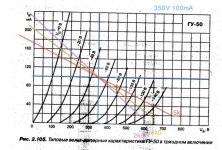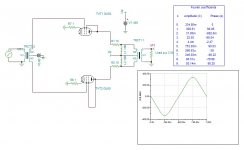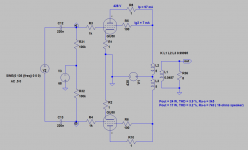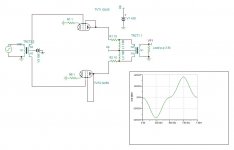Hi,
Any one can advice what the suitable OPT (push pull) for GU-50 wired as triode @ Vp ~ 300-350V 80-100ma per side?
Some one also offer me 2 choices: 4.6K p-p with UL tab, -vs- 6.6K p-p with cathode feedback (originally for QUAD Kt88 clone amp, no UL), and wondering which one can be use?
Thanks.
Any one can advice what the suitable OPT (push pull) for GU-50 wired as triode @ Vp ~ 300-350V 80-100ma per side?
Some one also offer me 2 choices: 4.6K p-p with UL tab, -vs- 6.6K p-p with cathode feedback (originally for QUAD Kt88 clone amp, no UL), and wondering which one can be use?
Thanks.
I want to try it : A 3,5k push-pull transformer, 300 V ,triode strapped as follow:
K+G3,(G2+ 100Ω)+A.
GU50 as triode do not work well with such low supply voltage.
I made some LT Spice simulations.
1. With +Ub = 300 V, RL = 3k5, Pout = 9 W (only)
2. With +Ub = 400 V, RL = 4k, Pout = 20 W
But i mean 300v for power supply voltage,not for the working point.
I this case grid voltage should be around -15v -20v.
With 300 V supply voltage and 105 mA plate current, Ug1 = -37 V. With Ug1 = -20 V the plate current would be 230 mA, which is fatal for GU50's.
Last edited:
Hello,
I started my push-pull triode strapped Gu50 .
Today i can supply 430v.
Output transformer is an 50w 3,5KΩ Push-pull plate to plate.
It can handle 170 mA max.
I thought I understood the charge lines. But the more I read the more I realize that I didn't understand anything.
Are these values correct ? Please
I thinked that Operating Point should be around -50v but now it seems that it could be around-70v.
Any review ?
Regards
I started my push-pull triode strapped Gu50 .
Today i can supply 430v.
Output transformer is an 50w 3,5KΩ Push-pull plate to plate.
It can handle 170 mA max.
I thought I understood the charge lines. But the more I read the more I realize that I didn't understand anything.
Are these values correct ? Please
I thinked that Operating Point should be around -50v but now it seems that it could be around-70v.
Any review ?
Regards
3.5k transformer impedance plate-plate is quite low for GU50, but anything goes.
The lower the load impedance the higher the output power which can be achieved but also the higher the distortion. I would possibly choose more like 7k for 400v in triode.
But try your OPT and decide whether you like it.
But first get the biasing right. The numbers depend on whether your circuit uses
fixed bias (GU50 cathodes tied to ground, negative voltage on grids) or
cathode bias (GU50 cathodes tied to ground via resistor, grids tied to ground).
1) fixed bias:
Supply = 430V, plate current 73mA per tube, dissipation 31W per tube, grid voltage = -65V = bias (in fixed bias the plate to cathode voltage is almost the same as the supply voltage)
2) cathode bias:
Supply = 430V, plate current 78mA, dissipation 29W, cathode resistor 680ohm per tube, cathode voltage 53V = - bias (in cathode bias the plate to cathode voltage is the supply minus the cathode voltage, so lower than in fixed, hence bias numbers are lower if we assume that you want a similar dissipation).
If a common cathode resistor is used for two tubes, the value is 340 ohms.
The lower the load impedance the higher the output power which can be achieved but also the higher the distortion. I would possibly choose more like 7k for 400v in triode.
But try your OPT and decide whether you like it.
But first get the biasing right. The numbers depend on whether your circuit uses
fixed bias (GU50 cathodes tied to ground, negative voltage on grids) or
cathode bias (GU50 cathodes tied to ground via resistor, grids tied to ground).
1) fixed bias:
Supply = 430V, plate current 73mA per tube, dissipation 31W per tube, grid voltage = -65V = bias (in fixed bias the plate to cathode voltage is almost the same as the supply voltage)
2) cathode bias:
Supply = 430V, plate current 78mA, dissipation 29W, cathode resistor 680ohm per tube, cathode voltage 53V = - bias (in cathode bias the plate to cathode voltage is the supply minus the cathode voltage, so lower than in fixed, hence bias numbers are lower if we assume that you want a similar dissipation).
If a common cathode resistor is used for two tubes, the value is 340 ohms.
I made a simulation too (again).
I got 24 W with 3.9 % THD (mostly 3rd.) with 8 ohms (3k5 p to p) and
17 W with 3.2 % THD with 16 ohms speaker (7k p to p).
In class AB₁ I get 16W with 8%, are you driving in class AB₂ with input swing over 68vp?
- Home
- Amplifiers
- Tubes / Valves
- OPT PP for GU50 Triode ?




